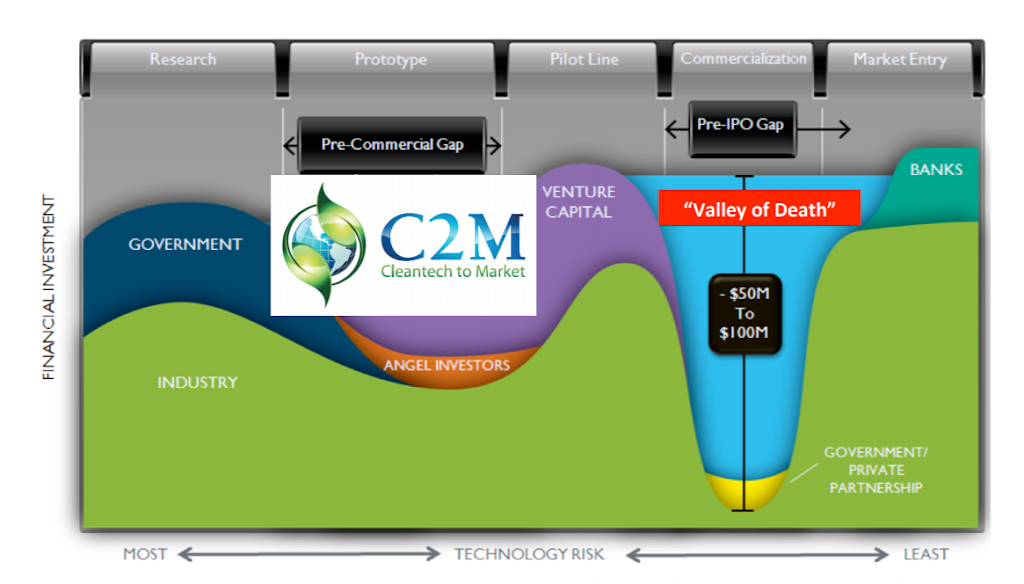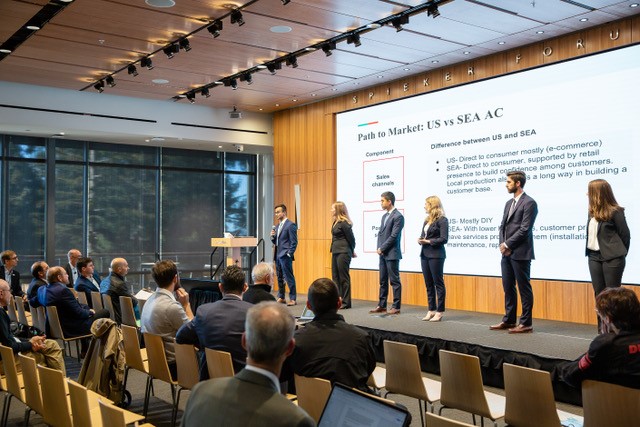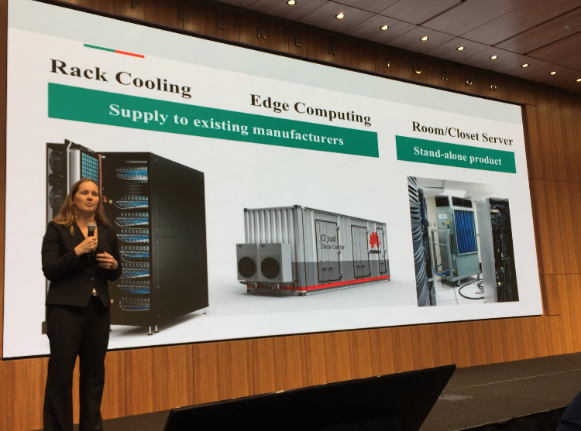
Prior to ERG, I developed installation sites for distributed power generation products on behalf of a clean tech start-up. It was there that I came to appreciate the complexity of the energy industry, and understand that we will need to learn how to commercialize innovative technologies within such highly regulated environments if we want to tackle global climate change.
Research and development in the electric power industry is notoriously underfunded — pharmaceuticals, information technology, and semiconductor firms spend between 15% and 20% of revenues on R&D, whereas electric firms spend less than 0.25% of revenue on R&D – but there is no guarantee of impact even after a scientific or technological breakthrough. There is still the matter of commercialization. A lot of functioning, important technologies die either in the pre-commercial gap (never find venture funding) or in the valley of death.
Berkeley Haas Business School’s Cleantech to Market (C2M) class provides free consulting to clean technology firms to help them through this journey from R&D to commercialization. Its goals are to prevent promising ideas from dying in the pre-commercial gap, and to train an interdisciplinary group of students to evaluate and pitch these technologies – valuable skills for their lives after graduate school.
So how does C2M work?
The class is only offered in the fall, but preparations for it start early in the year. The C2M directors spend the first few months of each year vetting technology groups (mostly early-stage companies, sometimes not-yet-companies) for an appropriate fit. In the spring, they start the application process with the students. Many of the students that apply are Haas MBAs, but they strongly encourage students from other disciplines like engineering, hard science, and policy to apply.
C2M first selects “team leads” from the pool of Haas MBA students. These team leads then select team members from the pool of class applicants. It is part NFL rookie draft, part medical residency program matching. You rank which technologies you are interested in working on. Team leads review your resume and statement and determine what kinds of skills they’ll need on their project. The selection process takes place over the summer.
My C2M Experience
Last year, I was matched into a team of four MBAs and one chemistry PhD to support a company developing a new kind of heat exchanger. Heat exchangers are critical pieces within a lot of technologies that we take for granted every day, so even incremental improvements to their efficiency can yield tremendous GHG emissions reductions.

Once the fall semester started, we got to work very quickly. We first learned as much as we could about heat exchangers, both technically, and where they fit into various markets. Then we questioned our client’s assumptions about their pathway to commercialization. We brainstormed every possible use of heat exchangers, what performance metrics were most important to them, and systematically evaluated how our technology’s innovation added value to that industry. We came up with multiple criteria for evaluation, then used that to narrow our search of potential fits.


Once we arrived at a handful of highest potential industries and applications, we set about the hard work of understanding these industries in great depth and quantifying the value add. We learned how to use techonomic models to do this, but we also learned a lot from directly interviewing dozens of industry professionals. This was an incredibly chaotic time with lots of information flowing in. Our six team members divided and conquered the monumental tasks, and somehow magically arrived at the end with great information and strong ideas about how our client might find success. Since the heat exchanger company had a good strategy for approaching their first market (US window air conditioning), we focused on their second and third markets, which they would also need. We ended up suggesting emerging market air conditioning and small-scale data center cooling, because both are underserved by current products on the market and have tremendous growth potential.
I pulled from my training in the dual ERG/MPP degree program during this process. I used back-of-the-envelope calculations and other skills from ER102 and ER200 to parse technical information. I applied skills from the policy curriculum to understand regulatory and policy drivers of markets.
I learned a lot from my teammates; it was an incredibly collaborative environment. Team leads get an additional unit in the course, because they must also dedicate time to steering the ship and learning how to be effective managers of high-output teams. They get a crash course in some of the best professional performance and management coaching, and I was incredibly impressed with how quickly they put it to effective use. I’d easily trade my team lead (who is many years my junior) for any number of bosses I’ve had in professional settings.
At the end of the semester, we produced a lengthy and professional market assessment report, and gave a twenty minute pitch in a formal setting to industry professionals at the C2M Symposium. Symposium attendees often go on to become funders of the technologies, and, as such, they ask very difficult questions after presentations. We practiced for weeks to refine our presentation, including the graphics, the speaking performance, our answers to anticipated questions. We ran it so many times, each of us knew our five minute pieces as well as any politician knows their stump speech. And our research was so comprehensive, we knew we could answer almost any question (we also practiced another important political/professional skill – how to pivot when you don’t know, or like, the real answer!).


We tied with another team for the Game Changer Award, for the technology with the most potential for global impact. We were especially proud of this award, because our competitors had some amazing technologies and presentations, and, well, it can be challenging to make heat exchangers exciting.

Why do C2M?
In the end, this was one of the most time-intensive courses I’ve taken in my graduate program, but also one of the most personally and professional rewarding. C2M gets great reviews, and justifiably brags about them. As someone who has been out in the commercial space for many years, I can attest that the skills you learn in the class are the ones required in the field. This is a phenomenal way to practice them, and you will end up creating some great industry relationships. I also got a better understanding of what it takes to go from early- to late-stage start-up, and learned so many interesting things about the other technologies my classmates were serving along the way.
This is a major commitment, but if you think you may benefit by having something like this under your belt, I highly recommend considering applying for the 2019 C2M. This is one important way for people with our kinds of skills to help make much-needed technology a reality, and you get so much out of it in the process.

C2M is holding an information session on Tuesday, April 2nd, 12:30 – 1:30pm at Haas N470.